Hobart and William Smith Colleges
Coordinates: 42°51′26″N 76°59′07″W / 42.857123°N 76.985407°W
|
Seals of the two colleges | |
| Motto |
Hobart: Disce William Smith: ΒΙΟΣ, ΨΥΧΗ |
|---|---|
Motto in English |
Hobart: Learn William Smith: Life, Soul |
| Type | Private liberal arts college |
| Established |
Hobart: 1822 Wiliam Smith: 1908 |
Religious affiliation | Episcopal Church |
| Endowment | $205 Million |
| President | Mark Gearan |
Academic staff | 225 |
| Undergraduates | 2,344 |
| Location | Geneva, New York, U.S. |
| Campus | small town |
| Colors |
Hobart: Orange and Royal Purple William Smith: Emerald Green and White |
| Athletics |
NCAA Division III Liberty League, MAISA, ECAC |
| Nickname |
Statesmen (Hobart) Herons (WS) |
| Affiliations | Annapolis Group |
| Website |
www |
 | |
Hobart and William Smith Colleges (collectively, The Colleges of the Seneca) are located on 195 acres (0.79 km2) in New York state's Finger Lakes region in Geneva, New York, United States. They trace their origins to Geneva Academy established in 1797. Hobart College (men) and William Smith College (women) are both liberal arts colleges offering the degrees of bachelor of arts, bachelor of science, and master of arts in teaching.
History
Hobart and William Smith Colleges, private colleges located in Geneva, New York, began on the western frontier as the Geneva Academy. After some setbacks and disagreement among trustees, the Academy suspended operations in 1817. By the time Bishop John Henry Hobart, of the Episcopal Diocese of New York, first visited the city of Geneva in 1818, the doors of Geneva Academy had just closed. Yet, Geneva was a bustling Upstate New York city on the main land and stage coach route to the West. Bishop Hobart had a plan to reopen the Academy at a new location, raise a public subscription for the construction of a stone building, and elevate the school to college status. Roughly following this plan, Geneva Academy reopened as Geneva College in 1822 with conditional grant funds made available from Trinity Church in New York City. Geneva College was renamed Hobart College in 1852 in honor of its founder, Bishop Hobart.
William Smith College was founded in 1908, originally as William Smith College for Women. Its namesake and founder was a wealthy local nurseryman, benefactor of the arts and sciences, and philanthropist. The school arose from negotiations between William Smith, who sought to establish a women's college, and Hobart College President Langdon C. Stewardson, who sought to redirect Smith's philanthropy towards Hobart College. Smith, however, was intent on establishing a coordinate, nonsectarian women's college, which, when realized, coincidentally gave Hobart access to new facilities and professors. The two student bodies were educated separately in the early years, even though William Smith College was a department of Hobart College for organizational purposes until 1943. In that year, following a gradual relaxation of academic separation, William Smith College was formally recognized as an independent college, co-equal with Hobart. Both colleges were reflected in a new, joint corporate identity under the name "The Colleges of the Seneca."
Geneva Academy
Geneva Academy was founded in 1796 when Geneva was just a small frontier settlement. It is believed to be the first school formed in Geneva.[1] The area was considered "the gateway to Genesee County" and was in the early stages of development from the wilderness.[2] Geneva Academy was founded by Rev. Henry Axtell.
On May 3, 1796, a special meeting was held, as recorded in town of Seneca records, and three commissioners were chosen to receive the moneys granted by the state for the "use of schools."[2]
On January 30, 1807, twenty-three "freeholders" of Geneva petitioned the Regents of the State of New York for the incorporation of Geneva Academy.
The petition document is the oldest extant document in which the academy is mentioned by name, as follows: "Your petitioners beg leave further to represent that the real estate belonging to their Academy consists of a lot of land fronting the public square in the said village of Geneva, on which they have erected a building twenty-five feet by thirty-eight feet, and one and a half stories high, and that they have for upwards of two years past employed a gentleman of abilities, regularly graduated at Princeton College, who, together with an assistant, has the superintendence of upwards of sixty students."[1]
The petition was not granted and the academy was not granted a charter until March 29, 1813.[1]
On August 7, 1809, the trustees of the academy announced the engagement of the Rev. Andrew Wilson, formerly of the University of Glasgow in Scotland as head of the school.[1] He remained until 1812 when Ransom Hubell, a graduate of Union College, was made principal of the academy.[1] He was engaged to teach the respective branches of literature on the following terms: First Class-Reading, writing and arithmetic, 2 dollars 25 cents per quarter; Second Class-English grammar, book-keeping, geography and mathematics, including geometry, mensuration, algebra, surveying, navigation and astronomy, 4 dollars per quarter; and Third Class-The Latin, Greek and Hebrew languages, 5 dollars per quarter. The tuition fees had to be payable in advance.
In 1817, Hubbell was succeeded by the Rev. John S. Cook. On December 8, 1817, due to some "differences of feeling,"[1] a meeting of the board of trustees was held and it was decided that the academy operations should be suspended. A committee was appointed consisting of the Rev. Henry Axtell, James Carter, and David Cook, to take charge of the school building and allow use by "any respectable teacher" until the trustees came to a decision and resumed their duties.[1]
The first meeting after the suspension didn't take place until March 6, 1821, over four years later. It was called by trustee James Rees to announce that Trinity Church in New York City had bequeathed an endowment of $750 per annum to the school, specifically for the support of an academy at Fairfield, New York.[1]
One of the conditions of the grant from Trinity Church was that the residents of Geneva should erect a building for the accommodation of the "Branch Theological School." Another stipulation required that the site location be chosen by Bishop Hobart.[1] Agreeable to the resolution, the bishop viewed several sites in Geneva and on March 17, 1821, he communicated to the trustees his selection of the college site.[1]
The Rev. Daniel McDonald D.D., formerly principal of the Fairfield Academy, was appointed principal of Geneva Academy.[1] The academy reopened its doors on April 25, 1821, in a frame schoolhouse erected in 1817 in the rear of Trinity Church in Geneva.[1]
By 1822, Geneva had 1,700 inhabitants, 250 dwellings, a bank, land office and sundry shops and mills. It was the commercial center of the growing Finger Lakes region of New York state.[2]
Early pioneers felt the need of "education advantages" beyond what the academy could provide for their children. At the request of Trinity Church,[1] they began raising funds using voluntary labor and subscription. "They boldly built Geneva Hall before they applied to the state for a charter."[2] By the spring of 1822,[1] sufficient community funds had been raised to complete Geneva Hall, a stone structure that is still in use today. #mdsc33016
Geneva College
On April 10, 1822, Geneva College received a provisional charter. The State Regents of New York demanded the accumulation of funds yielding $4,000 per year before a permanent charter was granted. The college was accorded a three-year grace period to meet this requirement.[2]
The Regents granted the full charter on February 8, 1825, and at that time, Geneva Academy officially changed its name to Geneva College.[1] Rev. J. Adams was president of the college as of 1827.
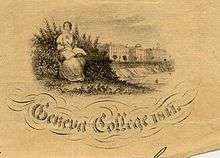
Creative financing by the founders of Geneva College plagued their successors for several decades. In a marketing effort, the founders sent agents selling certificates, which for $100 entitled "the subscriber, his heirs and assigns, to the privilege of sending one student to the Geneva Academy (or to Geneva College) for 20 years, commencing from the date hereof or any time he choose."[2]
The certificates became known as "The Little Old Men of the Sea," because decade after decade they were turned in for redemption and caused much consternation for the college fathers. Times changed and the cost of education and the cost of living in Geneva soared, leaving quite a financial burden for the school. The last certificate showed up in 1930 and was honored by Hobart College.[2]
In 1824, a course in "practical business" was instituted, a creative concept during those days. "In direct reference to the practical business of life by which the Agricultural, the Merchant and the Mechanic may receive a practical knowledge of what genius and experience have discovered without passing through a tedious course of Classical Studies."[2] This course was in addition to the traditional college program.[2]
The "English Course," as it was known, was a radical departure from long established educational usage and represented the beginning of the college work pattern found today.[2]
Geneva Medical College
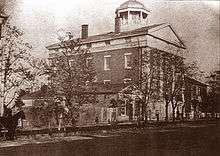
Geneva Medical College was founded on September 15, 1834, as a separate department (college) of Geneva College. The medical school was founded by Edward Cutbush, who also served as the first dean for the school.[2] In 1871, Hobart College disbanded the medical school and sold its library, anatomical specimens, and other tangible assets to Dean John Towler, who donated them to Syracuse University on condition that the trustees immediately establish an American Medical Association-approved medical school. Thus the Syracuse University College of Medicine came into being on December 4, 1871, with Frederick Hyde as dean.[3]
The period of greatest prosperity for the school occurred between the years 1840 to 1850. During that time, a total of 596 physicians graduated from the college.[1]
Elizabeth Blackwell

Amid many distinguished male graduates was one woman. In an era when the prevailing conventional wisdom was that no woman could withstand the intellectual and emotional rigors of a medical education, Elizabeth Blackwell, (1821–1910) applied to and was rejected – or simply ignored – by 29 medical schools before being admitted in 1847 to the Medical Institution of Geneva College.[4]
The medical faculty, largely opposed to her admission but seemingly unwilling to take responsibility for the decision, decided to submit the matter to a vote of the students. The men of the College voted to admit her.[5]
Blackwell graduated two years later, on January 23, 1849, at the top of her class to become the first woman doctor in the Northern hemisphere.[4] "The occasion marked the culmination of years of trial and disappointment for Miss Blackwell, and was a key event in the struggle for the emancipation of women in the nineteenth century in America."[4]
Blackwell went on to found the New York Infirmary for Women and Children and had a role in the creation of its medical college.[4] She then returned to her native England and helped found the National Health Society and taught at the first college of medicine for women to be established there.
Hobart College
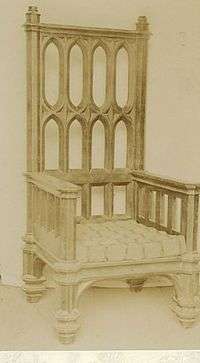
The school was known as Geneva College until 1852, when it was renamed in memory of its most forceful advocate and founder, Bishop Hobart, to Hobart Free College. In 1860, the name was shortened to Hobart College.[2]
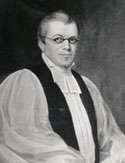
Hobart College of the 19th century was the first American institution of higher learning to establish a three-year "English Course" of study to educate young men destined for such practical occupations as "journalism, agriculture, merchandise, mechanism, and manufacturing", while at the same time maintaining a traditional four-year "classical course" for those intending to enter "the learned professions." It also was the first college in America to have a Dean of the College.
Notable 19th-century alumni included Albert James Myer, Class of 1847, a military officer assigned to run the United States Weather Bureau at its inception, was a founding member of the International Meteorological Organization, and helped birth the U.S. Signal Corps, and for whom Fort Myer, Virginia, is named; General E. S. Bragg of the Class of 1848, colonel of the Sixth Wisconsin Regiment and a brigadier general in command of the Iron Brigade who served one term in Congress and later was ambassador to Mexico and consul general of the U.S. in Cuba; two other 1848 graduates, Clarence A. Seward [6] and Thomas M. Griffith, who were assistant secretary of state and builder of the first national railroad across the Mississippi River, respectively; and Charles J. Folger, Class of 1836, a United States Secretary of the Treasury in the 1880s.
Until the mid-20th century, Hobart was strongly affiliated with the Episcopal Church and produced many of its clergy. While this affiliation continues to the present, the last Episcopal clergyman to serve as President of Hobart (1956–1966) was Louis Melbourne Hirshson. Since then, the president of the colleges has been a layperson.
During World War II, Hobart College was one of 131 colleges and universities nationally that took part in the V-12 Navy College Training Program which offered students a path to a Navy commission.[7]
Founding of William Smith College
Toward the end of the 19th century, Hobart College was on the brink of bankruptcy and suffering through a period of financial uncertainty. It was through the presidency of Langdon Stewardson that the college obtained a new donor, nurseryman William Smith. William Smith had already built the Smith Opera House in downtown Geneva and the Smith Observatory on his own property when he became interested in founding a college for women, a plan that he pursued to the point of breaking ground before realizing that the plan was beyond even his means. As publicized in The College Signal on October 7, 1903, "William Smith, a millionaire nurseryman, will found and endow a college for women at Geneva, N. Y., to be known as the William Smith College for Women The institution will be in the most beautiful section. One building is to cost $150,000. Mr. Smith maintains the Smith observatory there."[8] In 1903, Hobart College President Langdon C. Stewardson learned of Smith's interest and, for two years, attempted without success to convince him to make Hobart College the object of his philanthropy. With enrollments down and its resources strained, Hobart's future depended upon an infusion of new funds.

Unable to convince Smith to provide direct assistance to Hobart, President Stewardson redirected the negotiations toward founding a coordinate institution for women, a plan that appealed to the philanthropist. On December 13, 1906, he formalized his intentions; two years later William Smith School for Women – a coordinate, nonsectarian women's college – enrolled its first class of 18 students. That charter class grew to 20 members before its graduation in 1912.
In addition, Smith's gift made possible construction of the Smith Hall of Science, to be used by both colleges, and permitted the hiring, also in 1908, of three new faculty members who would teach in areas previously unavailable in the curriculum: biology, sociology, and psychology.
Origins of the coordinate system
Despite some sharing of facilities, at the beginning of their relationship the two colleges were quite separate. Classes were conducted in duplicate, and women students were not allowed on the Hobart campus. Those who required access to Trinity and Merritt halls (where chemistry and physics classes were held), the library, and the chapel traveled there on public sidewalks along the campus perimeter.
The enforced separation of the colleges eroded gradually over the years. In 1922, the first joint commencement was held, but baccalaureate services remained separate until 1942. By then, the practice of holding duplicate classes was less observed, particularly in upper-level courses with few students. In 1938, first-year courses were held in common, without any of the dire consequences that some had predicted, and by 1941 coeducational classes had become the norm.
In 1943, during the administration of President John Milton Potter, William Smith College was elevated from its original status as a department of Hobart College to that of an independent college, co-equal with Hobart. At President Potter's suggestion, the two colleges established a joint corporate identity, adopting a "family name", The Colleges of the Seneca, which still is the legal name of the combined corporation. For a detailed explanation of the shared and structurally separate elements of the Colleges as they now exist, see Coordinate System below.
Hobart seal
Arthur Cleveland Coxe, the namesake of Bishop Arthur Cleveland Coxe, his grandfather (for whom Coxe Hall is named),designed the seal in 1895. The Latin phrase "Sigillvm Collegii Hobartiani in Civ Neo Ebor", along the margin of the seal, translates as "The Seal of Hobart College in the State of New York," "Civ" being short for "Civitate" and "Ebor" for "Eboraco," the ablative case of Eboracum, the Latin name of York. "Vita Lux Hominvm", the phrase on the scroll, translates "Life and Light of Mankind." "Disce" is the Latin singular imperative (command) for "learn," and is a charge to the students to excel, while 1822 signifies the date of the College's charter. On the shield, the book represents learning and education, the cross, religion. The key on the left may symbolize knowledge. The crossing key, on the right, is symbolic of the bishop's crook, a reminder of the College's founder, Bishop Hobart.
William Smith seal
The seal of William Smith College depicts a lamp, which is the traditional symbol of enlightenment and education. Greek words meaning "life" and "soul" are placed above the lamp. This suggests that the College is concerned with all phases of life and attempts to meet both the physical and spiritual needs of the students. The date of the founding, 1908, is at the base of the lamp, and the inner field is surrounded by boughs of laurel
World War II
Between 1943 and 1945, Hobart College trained almost 1,000 men in the U.S. Navy's V-12 program, many of whom returned to complete their college educations when the post-World War II GI Bill swelled the enrollments of American colleges and universities. In 1948, three of those veterans – William F. Scandling, Harry W. Anderson, and W. P. Laughlin – took over operation of the Hobart dining hall. Their fledgling business was expanded the next year to include William Smith College; after their graduation, in 1949, it grew to serve other colleges and universities across the country, eventually becoming Saga Corporation, a nationwide provider of institutional food services.
Campus
Layout
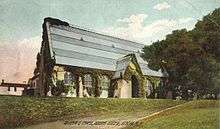
Hobart and William Smith Colleges' campus is situated on 170 acres (0.69 km2) in Geneva, New York, along the shore of Seneca Lake, the largest of the Finger Lakes. The campus is notable for the style of Jacobean architecture represented by many of its buildings, notably Coxe Hall, which houses the President's Office and other administrative departments. In contrast, the earliest buildings and the chapel are Gothic in style.

The Quad, the core of the Hobart campus, was formed by the construction of Medbery, Coxe, and Demarest. Several years later, Arthur Nash, a Hobart professor, designed Williams Hall, which would be constructed in the gap between Medbery and Coxe. The Quad is formed to the east by Trinity and Geneva Hall, the two original College buildings, and to the south by the Science compound, and Napier Hall. Geneva Hall (1822) and Trinity Hall (1837) were added to the National Register of Historic Places in 1973.[9] In 2016, the schools announced that they were going solar by building two solar farms to create enough electricity for about 50 percent of HWS' needs.[10]
The Hill (or William Smith Hill) is a prominent feature of the historic William Smith campus. Located at the top of a large sloping hill to the West of Seneca Lake and the Hobart Quad, the Hill houses three historic William Smith dorms, and one built in the 1960s (Comstock, Miller, Blackwell, and Hirshson Houses). At its peak resides William Smith's all female dorms. The Hill was the site originally conceived for William Smith College. Unveiled in 2008 for the William Smith Centennial is a statue of the college's founder and benefactor, William Smith.
A 15 million dollar expansion of the Scandling Campus Center was completed in autumn 2008. This renovation added over 17,000 additional square feet, including an expanded cafe, a new post office, and more meeting areas. In 2016 the Gearan Center for Performing Arts was completed at a cost of 28 million dollars; the largest project in the history of the colleges. This 65,000 square foot facility brings together music, dance, theater and media and society in a unified academic space.
Key buildings
Coxe Hall, serves as the main administrative hub of campus. Constructed in 1901, the building is named after Bishop Arthur Clevland Coxe, a benefactor of the school, and houses the president's office, Bartlett Theater, The Pub, and a classroom wing, which was added in the 1920s. Arthur Cleveland Coxe was closely affiliated with the school. The building was designed by Clinton and Russell Architects.
Gearan Center for the Performing Arts, named in honor of President Mark D Gearan and Mary Herlihy Gearan, is a state of the art facility completed in 2016. It includes a light-filled lobby that links three flexible performance and rehearsal spaces designed specifically for theater, music and dance. Adaptable seating allows for the creation of spaces that can be changed to accommodate multiple types of productions and audience sizes. Also included are faculty offices, practice and recital rooms and a film screening room.
Scandling Campus Center, named after William F. Scandling '49, is the central hub of student life. Scandling, renovated and expanded in 2009, houses Saga (the dining hall), the post office, offices of student activities, a cafe, and Vandervort room (a large event space).
Gulick Hall, was built in 1951 as part of the post-war "mini-boom" that also included the construction of the Hobart "mini-quad" dormitories Durfee, Bartlett, and Hale (each named for a 19th-century Hobart College president). Gulick Hall originally housed the campus dining services and, later, the Office of the Registrar. Completely renovated in 1991, Gulick now houses both the Office of the Registrar and the Psychology department, which was moved from Smith Hall in 1991 prior to its renovation in 1992.
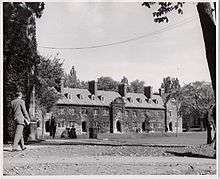
Stern Hall, named for the lead donor, Herbert J. Stern '58, was completed in 2004. It houses the departments of economics, political science, anthropology & sociology, environmental studies and Asian languages and cultures.
Smith Hall, built in 1907, originally housed both the Biology and Psychology Departments. It is now home to the Dean's Offices of both colleges, along with the departmental offices of Writing and Rhetoric and the various modern language departments. Smith Hall was the first building constructed with funds from William Smith on the William Smith College campus, but it is also the first building that has always been shared by both colleges.
Williams Hall, completed in 1907, housed the first campus gymnasium and, after the construction of Bristol gymnasium, served several other lives as campus post office, book store, and, presently, home of the Music Department and IT services.
Demarest Hall, connected to St. John's Chapel by St. Mark's Tower, houses the departments of Religious Studies and English and Comparative Literature as well as the Women's Studies Program. Also home to the Blackwell Room, named in honor of Dr. Elizabeth Blackwell (once used as study area and library, the space is now used for classrooms in the absence of more intentional planning for classroom space), Demarest was designed by Richard Upjohn's son, Richard M. Upjohn. (Upjohn's grandson, Hobart Upjohn would design several of the College's buildings as well). Demarest served as the College's library until the construction of the Warren Hunting Smith Library in the early 1970s. In the 1960s it was expanded to hold the College's growing number of volumes. Today, it also houses the Fisher Center for the Study of Women and Men, an intellectual center led by such scholar faculty as Dunbar Moodie (Sociology), and Betty Bayer (Women's Studies).

Trinity Hall built in 1837, was the second of the colleges' buildings. Trinity Hall was designed by college president Benjamin Hale, who taught architecture. Trinity served as a dormitory and a library, but it was converted into a space for classrooms, labs, and offices later in the 19th century. It presently is home to the Salisbury Center for Career Services.

Merrit Hall, completed in 1879, was built on the ruins of the old medical college. Merrit was the first science building on campus and housed the chemistry labs. Merrit also housed a clock atop the quad side of the building. On the eve of the Hobart centennial in 1922, students climbed to the top and made the bell strike 100 times. Merrit Hall was also one of the first buildings shared by Hobart and William Smith. Today Merrit Hall houses a lecture hall and faculty offices. St. John's Chapel, designed by Richard Upjohn the architect of Trinity Church in New York City, served as the religious hub of the campus, replacing Polynomous, the original campus chapel. In the 1960s, St. John's was connected to Demarest Hall by St. Marks Tower.
Houghton House, the mansion, known for its Victorian elements, is home to the Art and Architecture departments. The country mansion was built, in the 1880s by William J. King. It was purchased in 1901 by the wife of Charles Vail (maiden name Helen Houghton), Hobart graduate and professor, as the family's summer home. Mrs. Vail remodeled the Victorian mansion's interior to the present classical decor in 1913. The family's "town home" is 624 S. Main Street and is now the Sigma Phi fraternity. Helen Vail's heirs donated the house and its grounds to the colleges to be used as a woman's dormitory. After many years as a student dorm, the house became home to the art department after the original art studio was razed to make way for the new Scandling Campus Center. The building is now home to the Davis Art Gallery, with lecture rooms, multiple faculty offices, and architecture studios on the top floor.
Katherine D. Elliot Hall, was constructed in 2006. The "Elliot" houses 14,600 square feet (1,360 m2) contains art classrooms; offices; studios for painting, photography, and printing; and wood and metal shops.

Goldstein Family Carriage House, was built by William J. King in 1882 and was renovated in 2006 to house a digital imaging lab and a photo studio with a darkroom for black-and-white photography.
Warren Hunting Smith Library, in the center of the campus, houses 385,000 volumes, 12,000 periodicals, and more than 8,000 VHS and DVD videos. In 1997, the library underwent a major renovation, undergoing several improvements, such the addition of multimedia centers, and the addition to its south side of the L. Thomas Melly Academic Center, a spacious, modern location for "round the clock" study.
Napier Hall, attached to the Rosenberg Hall, houses several classrooms and was completed in 1994.
Rosenberg Hall, named for Henry A. Rosenberg (Hobart '52), is an annex of Lansing and Eaton Hall, the original science buildings. Rosenberg houses many labs and offices.
Lansing Hall, built in 1954, is home to Sciences and Mathematics. The building is named for John Ernest Lansing, Professor of Chemistry (1905–1948), who twice served as acting president.
Eaton Hall, is named for Elon Howard Eaton, Professor of Biology (1908–1935). Eaton, one of New York's outstanding ornithologists, was one of the professors brought to campus with William Smith grant funds. He received the Distinguished Faculty Award in 1992. Eaton Hall is a part of the science complex at the south end of the Hobart Quad, which consists of Lansing, Rosenberg, and Napier.
Dormitories
Men's dorms
Medbery Hall is an original Hobart College dorm dating from the 1900. Medbery defines the right side of the Hobart Quadrangle. Designed by Clinton and Russell architects at the same time as Coxe Hall, the two buildings share similarity in their Jacobean Gothic style. Medbery is adorned with a recognizable Flemish roofline. Medbery was designed without long hallways "conductive to rioting" and mischief, such as rolling a cannonball down the hallway. Such mischief was experienced in the other two dormitories on campus, Geneva and Trinity Halls.

Geneva Hall, built in 1822, is the college's first building, and the cornerstone site designated by the School's founder, Bishop John Henry Hobart. The building is one of the oldest academic building in continuous use, having served as a dormitory, among other uses, since its completion. The building has inscribed into its quoins, and alongside the perimeter of its facade, plaques which list the graduates of classes dating back to the 19th century.
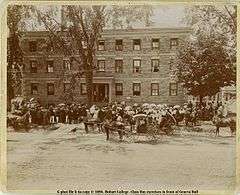
The Mini Quad, consisting of three building, Durfee, Hale, and Bartlett, houses about 150 Hobart students. Since the 2010 academic year, Hale is home to one floor of William Smith students.
Hale Hall is named for Benjamin Hale, president of Hobart College from 1836 to 1858.
Bartlett Hall was named after the Reverend Murray Bartlett, who served as fourteenth president of Hobart College from 1919 to 1936
Durfee Hall was named after William Pitt Durfee, who from 1884 to 1929 served as Professor of Mathematics and Chair of the Mathematics Department. He was the first dean of a liberal arts college and served as acting president of the Colleges four times.
Women's dorms
Blackwell House was designed and built in 1860 by Richard Upjohn as a residence for William Douglass, who served as a trustee of Hobart College. The house was purchased in 1908 as the first William Smith dormitory. The house still houses William Smith students and is known for its grand Victorian features from fireplaces, to chandeliers, to large old windows. Though rarely recognized as such, the house is named for Elizabeth Blackwell, an early graduate of what became the Colleges.
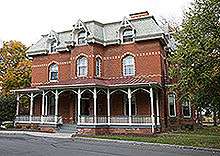
Comstock House was designed by Richard Upjohn's grandson, Hobart Upjohn, in 1932. Comstock is a women's dormitory named for Anna Botsford Comstock, friend of William Smith and the first woman to be named a member of the Board of Trustees.
Miller House was William Smith College's second dormitory. Miller was designed by Arthur Nash, professor and grandson of Arthur Cleveland Coxe. Nash also designed Smith Hall and Williams Hall. This house honors Elizabeth Smith Miller, a leader in the women's movement.
Hirshson House, completed in 1962, was named for the president of the colleges, Dr. Louis Melbourne Hirshson, the last Episcopal clegy person to serve in that capacity. The building is home to William Smith students.
Coed dorms
Jackson, Potter, Rees, together known as JPR for short (and once dubbed "superdorm"), the three identical buildings create their own quad in the south end of campus. The dorms were built in 1966 and are named after various historical figures of Hobart College. The complex houses about 230 first-year and upper class Hobart and William Smith students. The building was completely renovated in 2005 to include quad living spaces (two double bed rooms connected by a common living room) and open lounge spaces and lounges on every floor.
Jackson Hall is named for Abner Jackson, president of the Hobart in the middle of the 19th century. Jackson would go on to become president of Trinity College in Connecticut, where he would be the principal designer of its present campus.
Rees Hall is named for Major James Rees, an early settler and landowner in Geneva and an acquaintance of George Washington.
Potter Hall is named for John Milton Potter, President of Hobart and William Smith Colleges from 1942 to 1947.
"The Village at Odells Pond" is a collection of apartment style dorms that are available to upperclassmen at the colleges. The units have either four or five bedrooms, 2 bathrooms, a living room and a kitchen.
The surrounding ecosystem plays a major role in the Colleges' curriculum and acquisitions. The Colleges own the 108-acre (0.44 km2) Hanley Biological Field Station and Preserve on neighboring Cayuga Lake and hosts the Finger Lakes Institute, a non-profit institute focusing on education and ecological preservation for the Finger Lakes area.
On Seneca Lake one will find the William Scandling, a Hobart and William Smith 65-foot (20 m) research vessel used to monitor lake conditions and in the conduct of student and faculty research.
The Colleges also own and operate WEOS-FM and WHWS-LP, public radio stations broadcasting throughout the Finger Lakes and worldwide, on the web.
 Demarest Hall, 1920 |
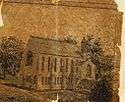 Proposed design for Demarest Hall, Richard M. Upjohn, 1895 |
 Blackwell Room, Demarest Hall |
 Room, Demarest Hall, 1945 |
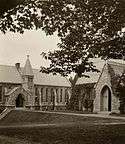 Demarest Hall and St. John's Chapel, 1929 |
 Demarest Hall, 1919 |
 St. John's Chapel |
 Trinity Hall and Middle Building (Burned 1885) |
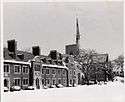 Medbery Hall with St. Mark's Tower visible |
 Coxe Hall Elevations (Clinton and Russell 1899) |
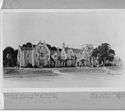 Proposed addition to Coxe Hall (Hobart Upjohn, 1930) |
 Coxe Hall, 1950s |
 Coxe Hall elevations (Clinton and Russell) |
 Coxe Hall, early 20th century |
HWS Bozzuto Boat House on Seneca Lake |
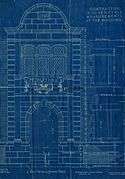 Blueprint for Medbery Hall, (Clinton and Russell) |
 Merrit Hall Chemical Lab |
 Medbery Hall, 1955 |
 Hobart Quadrangle after the completion of Coxe Hall, and Medbery Hall, 1901 |
 Looking south towards Hobart College |
Coordinate system
While publicized in tandem as "Hobart and William Smith Colleges," and informally referred to as "The Colleges," William Smith and Hobart have each retained its separate identity, while integrating many aspects of student life in an arrangement called the "Coordinate System." When many single-sex institutions became co-ed in the 1960s and '70s, the colleges, like others such as Columbia/Barnard, chose to maintain two separate entities, joined together in order to work as a whole. Though not donated for this purpose, a prior President, Richard H. Hersh, came to see the system as symbolized in the campus sculpture of a scissors embedded in the lawn south of the library.
The colleges share most administrative offices (there is only one president's office, for example, which differentiates the Colleges from one or more other coordinate systems) they maintain separate deans' offices, athletics programs, student governments and, until recently, admissions offices. Even some regulations about student life vary. Hobart College allows fraternities and Greek organizations while William Smith does not allow sororities.
A male graduate receives a degree from Hobart College and a female graduate from William Smith College. Alums are always referred to in the single-sex sense of the word, as "alumnae and alumni" and any reference to the institution is always in the plural ("colleges"). Of course, the coordinate system allows ease of transfer for those who transition from male to female or female to male during their time at the Colleges and thus offers a challenge both to single sex and co-educational systems.
Each college celebrates its own traditions. During the academic year, William Smith College celebrates annual events such as Founder's Day and Moving Up Day. Hobart has Charter Day, which celebrates the 1822 founding and its own honor societies: The Druid Society for seniors (founded 1903), Chimera Society (juniors, 1910) and Orange Key (sophomores, 1926). The William Smith Senior Honor Society is Hai Timiai ("Honored Women" in Greek). Each society has specific roles and functions on campus. In 2016 the Colleges considered changing the structure of the traditional commencement ceremony. Ultimately the Board of Trustees, administration and student conducted surveys decided to leave the current system in place. The change would have resulted in a completely uniform ceremony of both Hobart and William Smith graduates. The current divides the colleges into Hobart College and William Smith College for men and woman respectively.
Academics
Hobart and William Smith Colleges offer the degrees of bachelor of arts, bachelor of science, and master of arts in teaching. The colleges follow the semester calendar and have a student to faculty ratio of 11:1.
The colleges are known for the number of students that study abroad for a semester during the academic year; in recent years, between 40% and 60% of students have spent at least one semester studying off-campus. In former years, the majority of these terms abroad were led by faculty from the Colleges.
The Colleges have long been recognized for the high quality of their education and in 1961 were undefeated National Champions (an honor earned after winning five consecutive challenges) on the GE College Bowl, one of only three institutions in the United States to achieve this distinction at the time. In 2004, a William Smith student was selected as a Rhodes Scholar.
The Colleges have a long history of strength in interdisciplinary programs, including women's studies (well over 40 years old, and thus one of the first in the nation), Asian studies, environmental studies, and LGBT studies.
In addition to the Seneca Review, published on campus, from 2001 to 2004, Hobart and William Smith Colleges saw the publication of a literary magazine, SCRY!: A Nexus of Politics and the Arts. Under the editorial supervision of Binh Nguyen (Hobart '04), the magazine included contributions from both professionals and students. The Canadian poet/classicist Anne Carson appeared twice. John O'Brien, the founder of The Center for Book Culture, contributed. Award-winning on-campus writers, such as Jim Crenner, David Weiss, Deborah Tall and James McCorkle, submitted original poems. There were writings and artworks by students as well.
Elizabeth Blackwell Award
Given in her memory, the Elizabeth Blackwell Award is presented periodically by Hobart and William Smith Colleges to a woman who has demonstrated "outstanding service to humankind." Its recipients have included Chair of the Federal Reserve Janet Yellen (2015), the Most Rev.Katharine Jefferts Schori (2013), Eunice Kennedy Shriver (2011), first woman ordained a rabbi in the United States, Rabbi Sally Priesand (2009), Secretary of State Madeleine Albright (2001), tennis great Billie Jean King (1998), Wilma Mankiller (1996), first woman chief of the Cherokee Nation; U.S. Congressperson Barbara Jordan (1993), U.S. Senator Margaret Chase Smith (1991), former Surgeon General Antonia Novello (1991), Supreme Court Justice Sandra Day O'Connor (1985), and Fe del Mundo, the first Asian woman admitted to Harvard Medical School (1966), among many others.[11]
President's Forum
Each semester, Hobart and William Smith sponsors a series of guest lectures. The most prominent, the President's Forum, established in 2000, is hosted by current president Mark Gearan. The forum has included The Hon. Shireen Avis Fisher, Nancy Zimpher, Mary Matalin and James Carville, Kathy Platoni, Svante Myrick, Cornel West, Ralph Nader, Hillary Clinton, Eric Liu, and Alan Keyes, among other prominent names.
Publications
Echo and Pine is the annual student-produced college yearbook. Originally two separate publications, the Hobart Echo of Seneca, and the William Smith Pine, the two merged in the 1960s to create one publication to serve both colleges.
The Herald is the student-run school newspaper, originally founded in the late 19th century as the Hobart Herald.
The Pulteney St. Survey is the official magazine of Hobart and William Smith Colleges.
martini is the alternative student publication at Hobart & William Smith Colleges. Characteristically spelled with all lowercase letters, it provides a witty and critical look at music, politics, and social issues in a style that aspires to be "crisp, clean, and hard hitting." martini is published bi-weekly.
Thel is the Colleges' literary magazine.
Aleph is a journal of international travel, rooted in the colleges' strong study-abroad program.
Music
Collegiate ensembles
Hobart and William Smith has a number of ensemble groups, including:
Colleges Chorale, which is a mixed ensemble comprising the finest vocal talent on the campus. The students accepted into this 45-voice ensemble have gone through a careful audition process involving evaluation of both vocal technique and musicianship. The Chorale performs a wide range of a cappella choral repertoire—music from the Middle Ages to the present day. In addition to a formal concert at the end of each semester and the annual spring tour, the Colleges Chorale performs at various campus events throughout the year. Each spring the group takes a four-day tour. Recent tour destinations have included New York City, Philadelphia, Washington, D.C., and Boston.
Cantori is a chamber vocal ensemble comprising members from the larger Colleges Chorale. Since the group's formation in 1993, the sixteen-member Cantori has sought to foster contemporary choral music through the Cantori Commissioning Project – the annual commissioning and performance of a new work by a deserving American composer.
Guitar Ensemble, Under the direction of Kenneth Meyer
Jazz Ensemble, Under the direction of Bob Barbuto
Brass Ensemble, Under the direction of Jim Trowbridge
String Ensemble,
Woodwind Ensemble
Percussion Ensemble, Which frequently includes performers from other colleges.
Hobartones, Hobart College's student-run all-male a cappella group.
Three Miles Lost, William Smith College's student-run all-female a cappella group
Perfect Third, HWS's student run, coed a cappella group.
Greek life
Greek life has been integral to Hobart College historically. While William Smith has no sororities, Hobart has several active Chapters of Greek societies. Delta Chi, Hobart Chapter; Kappa Alpha Society, CH – NY Beta; Kappa Sigma, Delta-Phi Chapter; Phi Sigma Kappa, Psi Triton Chapter; Theta Delta Chi, Xi Charge; Sigma Chi, Alpha Alpha Chapter; Chi Phi; Hobart used to be the home of several now inactive fraternities including, Pi Lambda Phi, Beta Sigma, Phi Phi Delta, Sigma Phi Society, Tau Kappa Epsilon, and Phi Kappa Tau.
Athletics

- History
Originally known as the Hobart Deacons, Hobart's athletic teams became known as the "Statesmen" in 1936, following the football team's season opener against Amherst College. The morning after the game, The New York Times referred to the team as "the statesmen from Geneva," and the name stuck. The nickname for William Smith's athletic teams comes from a contest held in 1982. Several names were submitted, but "Herons" was selected because of the strong and graceful birds that lived at nearby Odell's Pond. These ominous birds frequently flew over the athletic fields as the teams were practicing.
- Facilities
Hobart and William Smith recently finished construction on the state of the art Caird Center for Sports and Recreation, which is now home to most of its athletics teams.
- Affiliations
The colleges compete in NCAA Division III, with the exception of men's lacrosse, which competes in the Division I Northeast Conference. The colleges' main conference affiliation is with the Liberty League with the following exceptions: Hobart hockey competes in the ECAC West; Hobart lacrosse competes in the Northeast Conference; and the William Smith golf team is an independent.
Varsity sports
Hobart sponsors 11 varsity programs (basketball, crew, cross country, football, golf, hockey, lacrosse, sailing, soccer, squash, tennis), while William Smith also sponsors 12 varsity programs (basketball, crew, cross country, field hockey, golf, lacrosse, sailing, soccer, squash, swimming & diving, tennis, and hockey).
- Football
Offensive linesman Ali Marpet, drafted in the 2nd round, 61st overall, of the 2015 NFL draft, is the highest-drafted pick in the history of Division III football.[12] He was three-time All-Liberty League first team (2012, 2013, 2014), and 2014 Liberty League Co-Offensive Player of the Year—the first offensive lineman in league history to be so honored.[13][14][15]
- Lacrosse
The Statesmen lacrosse team has compiled fifteen national championships (1 USILA, 2 NCAA Division II, and 13 NCAA Division III).
- Field hockey
The William Smith field hockey team has captured three national championships, ascending to the top of Division III in 1992, 1997 and 2000.
- Sailing
The lone coed team, the HWS sailing team is a member of the Middle Atlantic Intercollegiate Sailing Association. In 2005, the Colleges won the Inter-Collegiate Sailing Association Team Race National Championship and the ICSA Coed Dinghy National Championship.
- Soccer
The William Smith soccer team was the first Heron squad to capture a national championship, winning the 1988 title bout with a 1–0 victory over University of California, San Diego. The Herons won their second national championship in 2013 with a 2–0 victory over Trinity University, Texas.
- Crew
The Hobart Crew team has also found success, earning gold medals at the Head of The Charles Regatta, the ECAC National Invitational Regatta (most recently a gold in the 2nd varsity 8+ over the "Hometown Boys" of WPI in 2015), and the IRA National Championships. While the Hobart Crew team has won gold in every event they have entered since the inception of rowing as a Liberty League Sport, they failed to win the team championships only once (2004.) The eventual champions, Rensselaer Polytechnic Institute, were known for having a large team and only able to defeat the Statesmen by securing a win in the 2nd Varsity 8+ – the only event that Hobart did not have an entry. However, over the past few seasons Hobart has fielded one of the most dominant 2nd Varsity 8's in school history. The Crew Team took part in the Henley Royal Regatta in Henley, England in the summer of 2011, as well as the summer of 2015.[16]
Rivalries
Hobart's archrival in football is Union College in Schenectady, New York. Other team rivalries include Rensselaer (football, basketball); Rochester(football); Elmira and Manhattanville (hockey); Cornell (one of the oldest in lacrosse) and St. John Fishers in Victor, NY, Syracuse and Georgetown (lacrosse); and Michigan (crew). William Smith has rivalries in St. Lawrence (lacrosse, basketball, field hockey), Union (soccer, field hockey, basketball, lacrosse), Hamilton (field hockey, basketball and lacrosse) and Ithaca (crew).
Notable alumni
Notable alumni of Geneva Academy (1794–1825)
- Horatio Seymour (1823–1825) 18th Governor of New York, Democratic candidate for 1868 President against Ulysses S. Grant.
Notable alumni of Geneva College (1825–1852)
- General Edward Stuyvesant Bragg (1848) Lawyer; U.S. House of Representatives and Senator of Wisconsin. Union Bridadier General of Iron Brigade of Civil War. Chairman of Committee on Expenditures in the Dept. of Justice and Committee of War Claims. Appointed Envoy Extraordinary and Minister Plenipotentiary to Mexico. Appointed Consul General at Habana, Cuba, Hong Kong and China.
- Cornelius Cole (1847) Sacramento, California District Attorney and serving as both a U.S. Representative and U.S. Senator. Instrumental in founding the California Republican Party, Cole was a close friend of President Abraham Lincoln and advanced the interests of the Pacific Railroad both personally and politically, which led to the construction of the intercontinental railroad.
- Peter Myndert Dox (1833) Lawyer; Member of N.Y. State assembly; Judge of Ontario County Courts; Member of the U.S. House Representative of Alabama, 1869–1873.
- Charles J. Folger (1836) United States Secretary of the Treasury in the U.S. President Chester A. Arthur administration.
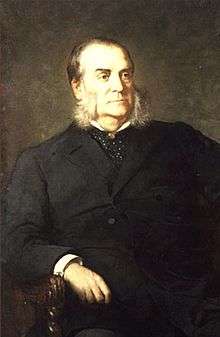
- Frederick S. Lovell (1835), member of the Wisconsin State Assembly. Union Brigadier General of the American Civil War.
- Albert J. Myer (1847) Father of the U.S. Army Signal Corps. A military officer assigned to run the United States Weather Bureau at its inception, was a founding member of the International Meteorological Organization.
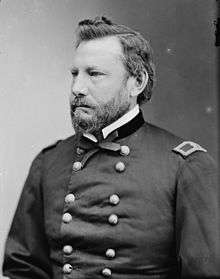
- George Washington Woodward (About 1828) Lawyer. US Congressman of Pennsylvania and Chief Justice of the Supreme Court of Pennsylvania.
Notable alumni of Geneva Medical College (1837–1871)
- Elizabeth Blackwell (1849) First woman awarded a Doctor of Medicine degree in the United States, graduated from the medical school of Geneva College.
- Robert Mitchell (1845), Wisconsin physician, Civil War surgeon and member of the Wisconsin State Assembly.
Notable alumni of Hobart and William Smith Colleges
- Dr. Willis A. Adcock (1944) Inventor of the silicon transistor, member of team that developed the atomic bomb.
- Jeffrey L. Amestoy (1968) Former Vermont Attorney General and Chief Justice.
- Byron Andrews (1876) journalist, private secretary to U.S. Pres. Ulysses S. Grant; received an honorary degree at Hobart in 1900.
- Darrick E. Antell (1973) New York City Plastic Surgeon, Diplomate of the American Board of Plastic Surgery.
- Harold Baer, Jr. (1954), Judge of the United States District Court for the Southern District of New York.
- Melissa Bank (1982) Author of The Girls' Guide to Hunting and Fishing.
- Eric Bloom (1967) Singer, songwriter, guitarist, and keyboardist, most recently of Blue Öyster Cult.
- Richard A. Brown (1953), District Attorney, Queens County, New York, June 1, 1991 to Present.
- Christian Camargo (Minnick) (1992) Actor, various movies and series, including Dexter, Fast, Inc., All My Sons (Broadway).
- Chris Carlin (1995) Sportscaster for the nationally syndicated radio show Imus in the Morning.
- The Rt Rev. Albert Arthur Chambers (1950), Seventh Bishop of Springfield, Illinois.
- Dr. Harry Coover (1941) Inventor of "super glue".
- Michael Bruce Curry, 27th Presiding Bishop of the Episcopal Church.
- Thomas Frederick Davies, Sr. (1889) Third Bishop of the Episcopal Diocese of Michigan 1889 – 1905.
- Frank Dwyer, Major League Baseball player.
- William Watts Folwell (1857), the first president of the University of Minnesota.
- Jeremy Foley (1974) Athletics Director at the University of Florida.
- Rodney Frelinghuysen (1969), United States Congressman representing New Jersey's 11th congressional district.
- Dr. Robert Peter Gale (1966), Leukemia and bone marrow disorders expert; Coordinated medical relief efforts for victims of the Chernobyl nuclear power accident.
- Evelyn Tooley Hunt (1926) Originator of American style of Haiku; Her poem Taught Me Purple was the inspiration for the book The Color Purple by Alice Walker.
- Holman W. Jenkins Jr, The Wall Street Journal editorial board member, policy commentator.
- Abigail Johnson, Fidelity Investments, CEO and President.
- Alan Kalter (1964), actor, announcer from the Late Show with David Letterman.
- Richard R. Kenney (1878) U.S. Senator, Delaware 1895 – 1900.
- Stephen Kuusisto (1978), American Poet.
- Joseph M. Kyrillos, New Jersey state Senator.
- Matt Lamanna (1997) Paleontologist responsible for several major discoveries.
- Eric Lax (1966), author, biographer for Woody Allen and Humphrey Bogart, amongst others.
- Reynold Levy (1966) President of the Robin Hood Foundation, former President of Lincoln Center for the Performing Arts.
- Warren Littlefield (1974) Head of programming for Sony Pictures Television and the former president of NBC Entertainment.
- Ali Marpet (2015), NFL football player. Drafted in the second round (61st overall) of the 2015 NFL Entry Draft by the Tampa Bay Buccaneers.
- Christopher McDonald (1977) Movie, Television, and stage actor (Happy Gilmore, Requiem for a Dream, The Perfect Storm, Quiz Show).
- Pierre McGuire (1983), two-time Stanley Cup winner; current Hockey Commentator for NBC Sports Network
- Arch Merrill, Rochester journalist and author of 26 books on local history and lore of the Genesee Country.
- Arthur Wheelock Moulton (1897) Episcopal Bishop of Utah.
- Greg Mullavey (1955), actor (Mary Hartman, Mary Hartman, The Rockford Files, Hawaii Five-O, iCarly).
- Mark Neveldine, screenwriter and director of films such as Gamer and Crank.
- The Rt Rev. George Elden Packard (1966), Episcopal Suffragan Bishop of the Armed Forces.
- Leslie Peirez, television producer.
- Lyman Pierson Powell became President of Hobart College in 1913. Renowned author, lecturer & ordained priest.
- Edward Regan (1950) Comptroller of New York in 1978 and president of Baruch College from 2000 to 2004.
- Milissa Rehberger (1993) News reporter, MSNBC.
- Richard M. Rosenbaum (1952), Politician and writer. Chief-of-Staff to NY Governor Nelson Rockefeller and New York Supreme Court Justice during a fourteen-year tenure.
- Robert Rusack (1947), was the fourth Episcopal Bishop of Los Angeles, California.
- William "Bill" Scandling (1949), Founder of the college meal plan, founder of Saga Corporation (sold to Marriott Corp., 1986).
- Jonas Schwartz Sports broadcaster, currently at SportsNet New York.
- Kent Smack (1997), 2004 Athens Olympic Rower for Team U.S.A.
- Herbert J. Stern (1958), Judge of the United States District Court for the District of New Jersey, United States Attorney, prosecuted Malcolm X killers.
- Jon Wallach (1989) Sports broadcaster, WEEI, WBZ-FM (The Toucher and Rich Show).
- Ben J. Wattenberg (1955), Journalist, PBS Host, and former speech writer for President Lyndon Johnson.
- Bill Whitaker (1973), CBS News Correspondent for the CBS Evening News and 60 Minutes.
- Ralph Walter Graystone Wyckoff (1916) Pioneer inventor of X-ray crystallography.
- John Paul Wiese (1962), Judge of the United States Court of Federal Claims.
- Brock Yates (1955), screenwriter of the film Cannonball Run and editor in chief of Car and Driver magazine.
Honorary degree recipients
- Byron Andrews – Received 1900.
- William Martin Beauchamp, S.T.D. – Received in 1886. Author on Native Americans, archeologist of New York State Museum[17]
- William Robert Brooks – Received in 1898.
- Henry Ustick Onderdonk – Received 1827. Bishop of Pennsylvania. Born 1789, died 1858.
- Henry Champlin Lay – A Bishop of the Episcopal Church in the United States of America, Diocese of Easton.
- Gulian Crommelin Verplanck – Received 1834.
Notable faculty

- William Stevens Perry (1832–1898) History Professor and President at Hobart College, Author and second bishop of the Episcopal Diocese of Iowa.
- William Robert Brooks (1844–1922), was an American astronomer who specialized in comet discovery and has some periodic comets named for him.
- Elon Howard Eaton, founded the biology department and was state ornithologist and author of bird books.
- H. Wesley Perkins, Professor of Sociology and the author of "Father of Social Norms Marketing."
- David Weiss, Professor of English and Comparative Literature, author of "The Mensch" and noted poet.
- Daniel A. McGowan, professor emeritus.
- Mark Gearan, President of Colleges, former White House Deputy Communications Director for President Bill Clinton, and former Director of the Peace Corps
- Susan Henking, President of Shimer College, Professor emerita, formerly professor of Religious Studies, Women's Studies, and LGBT Studies
- Benjamin Fish Austin (1850–1933), Campaigner for Women's Education. Also a renowned proponent of the Spiritualism movement.
- Matthew Kadane, Assistant Professor of History, main songwriter (along with brother Bubba) of Bedhead and The New Year.
- William A. Eddy, President of Hobart College, 1942
- Andrew Harvey, Professor of English and noted author on religion and mysticism.
Accreditation
Title IX sexual assault investigation
On May 1, 2014, the U.S. Department of Education released a list of 55 colleges being investigated for potential violations of federal law regarding sexual assault and harassment complaints.[18] The list included Hobart and William Smith Colleges.[19] A New York Times article published in July of the same year detailed a case in which a student reported a sexual assault by three college football players two weeks into her first year; within two weeks the college's investigation cleared the two men accused, despite medical evidence, a corroborating witness to one of the incidents and discrepancies in the alleged perpetrators' accounts of the evening. The story also alleged that the members of the disciplinary panel that heard the case were uninformed about sexual assault and frequently changed the subject rather than hear the victim's account of events.[20] Following the report, the colleges unveiled new initiatives and policies, including revising their sexual violence policies, creating a rape hotline and forming an Office of Title IX Programs and Compliance.[21]
References
- 1 2 3 4 5 6 7 8 9 10 11 12 13 14 15 16 "History of Ontario County – History of Geneva College in Geneva, New York.". D. Mason & Company, Syracuse, N.Y., 1893. Retrieved June 6, 2010.
- 1 2 3 4 5 6 7 8 9 10 11 12 "Hobart College, 125 Years Old, Prospers on Unusual.". Rochester Democrat and Chronicle. Rochester, New York. June 1, 1947.
- ↑ "History of the College of Medicine". SUNY Upstate Medical Center. Retrieved June 4, 2010.
- 1 2 3 4 "Dr. Elizabeth Blackwell's Graduation – An Eyewitness Account by Margaret Munro De Lancey" (PDF). Hobart and William Smith Colleges. Retrieved June 5, 2010.
- ↑ "Changing the Face of Medicine – Dr. Elizabeth Blackwell". National Library of Medicine. Retrieved June 5, 2010.
- ↑ "A Brief History of Clarence A. Seward". http://www.samueleells.org/. The Samuel Eells Literary and Educational Foundation. Retrieved 2015-03-02. External link in
|website=(help) - ↑ "The College Signal" (Semi-monthly published by the Students of the Massachusetts Agricultural College) Vol. XIV. October 7, 1903. p. 21.
- ↑ National Park Service (2009-03-13). "National Register Information System". National Register of Historic Places. National Park Service.
- ↑ "Hobart and William Smith Colleges go solar". Retrieved 2016-07-05.
- ↑ "Elizabeth Blackwell Award Recipients". Hobart and William Smith Colleges. Retrieved October 14, 2014.
- ↑ Kevin McGuire (May 2, 2015). "Ali Marpet puts D3 Hobart on the NFL Draft scoreboard – College Football Talk". NBC Sports.
- ↑ "Liberty League Athletics – Liberty League announces 2014 Football Award Recipients". Liberty League.
- ↑ "Press Release: News: Senior Bowl". seniorbowl.com.
- ↑ "AFCA Announces 2014 Division III Coaches All-America Team". afca.com.
- ↑ http://www.row2k.com/henley/features.cfm?ID=1216&site=henley#.VZ2gM_lViko
- ↑ The International Who's Who Pub. Co., 1911, p. 103
- ↑ U.S. Department of Education http://www.ed.gov/news/press-releases/us-department-education-releases-list-higher-education-institutions-open-title-i. Retrieved July 13, 2014. Missing or empty
|title=(help) - ↑ U.S. Department of Education http://www.ed.gov/news/press-releases/us-department-education-releases-list-higher-education-institutions-open-title-i. Retrieved 13 July 2014. Missing or empty
|title=(help) - ↑ Bogdanich, Walter (12 July 2014). "Reporting Rape and Wishing She Hadn't: How One College Handled a Sexual Assault Complaint". The New York Times. Retrieved 13 July 2014.
- ↑ Miller, Jim. "New initiatives, policies greet HWS students". Finger Lakes Times. Retrieved 2016-05-18.


.jpg)